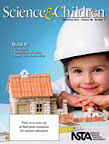Exploring natural and human-made materials
By Peggy Ashbrook
Posted on 2012-12-20
 “I found these two rocks in the sandbox and I think they’re from a volcano.” Children like to share their special found objects and talk about where they came from and what they might be. “I think this is a dead spider or a something else.” They like the way the rock feels, or the ambiguity of shape of the possible spider. Describing these found objects can be a challenge if the child does not have any experience with volcanoes or spiders. Children need outdoor experiences on and with natural materials to become familiar with which materials occur naturally and which are made by people from those natural materials. They need to observe many living organisms to be able to recognize the characteristic shape of a spider. If you don’t live near a volcano the child might not be able to compare the found rocks with volcanic rocks. The origin of the rocks might never be known for sure but wondering about where rocks come from could be supported by going on a walk to look for rocks, or taking a field trip to a naturally rocky place. (Visit the “Salt the Sandbox” site for great tips on finding rocks in a suburb without natural outcrops of rock.)
“I found these two rocks in the sandbox and I think they’re from a volcano.” Children like to share their special found objects and talk about where they came from and what they might be. “I think this is a dead spider or a something else.” They like the way the rock feels, or the ambiguity of shape of the possible spider. Describing these found objects can be a challenge if the child does not have any experience with volcanoes or spiders. Children need outdoor experiences on and with natural materials to become familiar with which materials occur naturally and which are made by people from those natural materials. They need to observe many living organisms to be able to recognize the characteristic shape of a spider. If you don’t live near a volcano the child might not be able to compare the found rocks with volcanic rocks. The origin of the rocks might never be known for sure but wondering about where rocks come from could be supported by going on a walk to look for rocks, or taking a field trip to a naturally rocky place. (Visit the “Salt the Sandbox” site for great tips on finding rocks in a suburb without natural outcrops of rock.)
 Even older elementary students have much to learn about materials and where they come from. In a column in the December 2012 Science and Children, “Science Shorts: Is Concrete a Rock?”, Katie Brkich writes about using place-based education, which begins teaching with the local environment, to teach students how to tell if materials occur naturally or are artificial or altered by humans. Students in grade 4 used “Is It a Rock?”, a probe from Uncovering Student Ideas in Science Volume 2, that asks students to explain their thinking, and tell what “rule” or reasoning they used to decide if an object is a rock or not.
Even older elementary students have much to learn about materials and where they come from. In a column in the December 2012 Science and Children, “Science Shorts: Is Concrete a Rock?”, Katie Brkich writes about using place-based education, which begins teaching with the local environment, to teach students how to tell if materials occur naturally or are artificial or altered by humans. Students in grade 4 used “Is It a Rock?”, a probe from Uncovering Student Ideas in Science Volume 2, that asks students to explain their thinking, and tell what “rule” or reasoning they used to decide if an object is a rock or not.
Children in preK to grade 2 are also able to explain their thinking. When children come to me asking, “What is this?” about an unknown object, I often ask them, “What could it be?” This prompts them to share their observations and past experiences to explain their ideas. The explanations are often incomplete. When I hear that the gray melange stones (found in our volcano-free region) might be from a volcano, I see no point in bursting the child’s bubble by saying, “I doubt it.” (I also don’t say I agree that it could be from a volcano.) Instead I can use the excitement about finding an interesting rock to encourage the child to look closely at other rocks and become familiar with the variety of textures, colors, and luster of local and rock. We might start a Found Rock Collection and use children’s developing literacy skills to label their finds.
Some programs provide a variety of natural materials for students to use in making “projects” (art creations of any kind). In the December 2012 Science and Children Early Years column I write about making a Materials Museum where children write, dictate and draw on a card to describe materials they find or bring from home, or those you provide because you think they are important for the children to explore. Later, after the materials are explored, described and displayed, they can be used for art creations.
Disclaimer: The views expressed in this blog post are those of the author(s) and do not necessarily reflect the official position of the National Science Teaching Association (NSTA).

